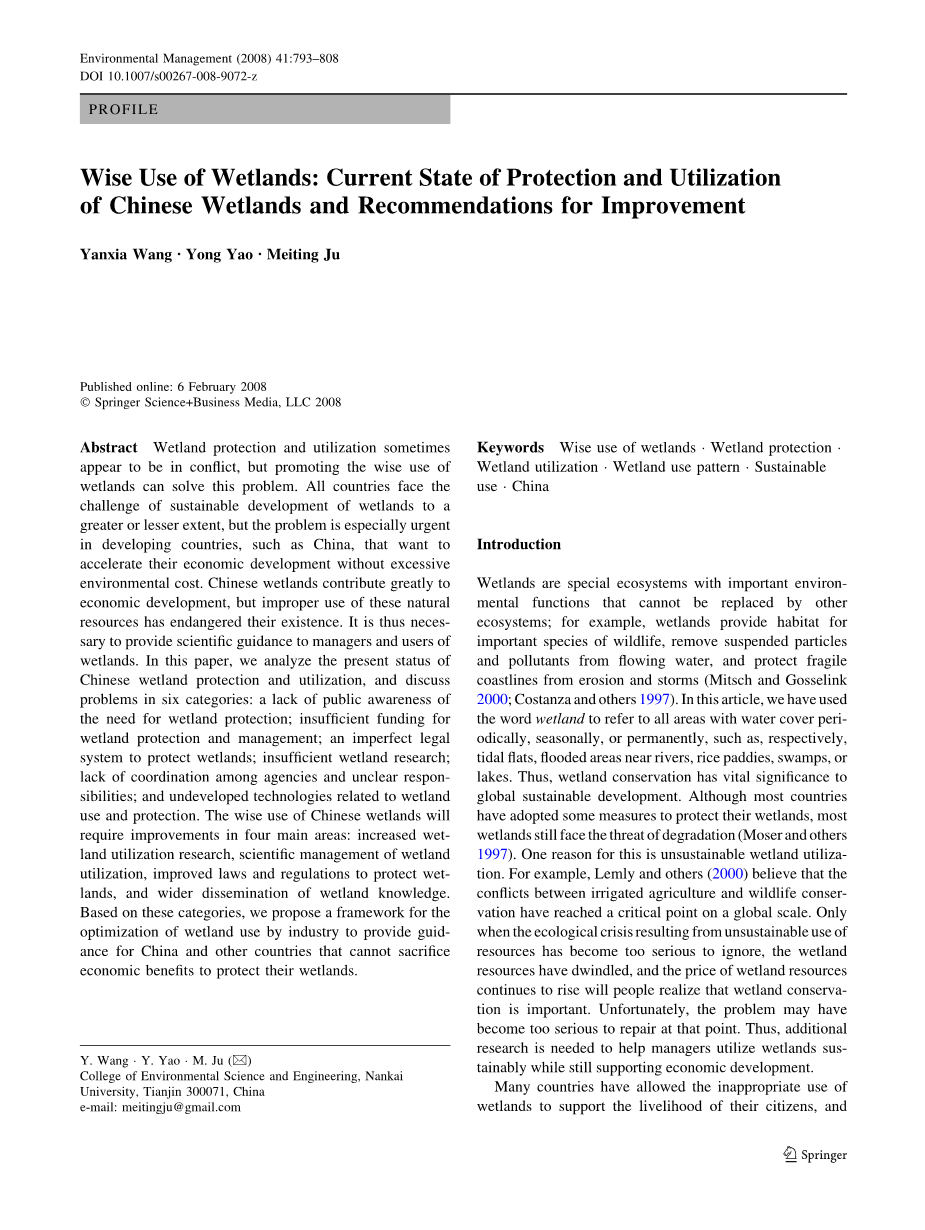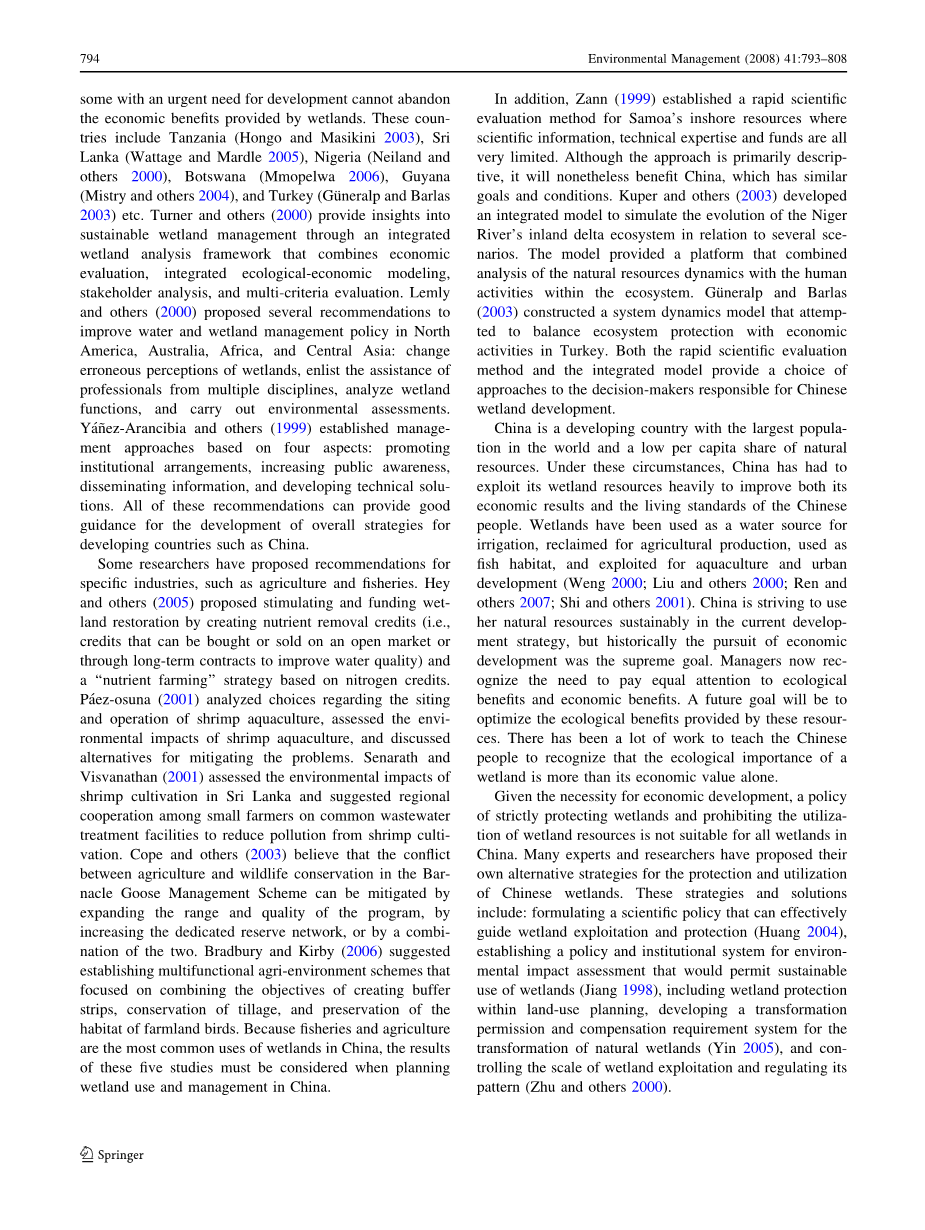

英语原文共 16 页,剩余内容已隐藏,支付完成后下载完整资料
Wise Use of Wetlands: Current State of Protection and Utilization of Chinese Wetlands and Recommendations for Improvement
Yanxia Wang AElig; Yong Yao AElig; Meiting Ju
A bstract Wetland protection and utilization sometimes appear to be in conflict, but promoting the wise use of wetlands can solve this problem. All countries face the challenge of sustainable development of wetlands to a greater or lesser extent, but the problem is especially urgent in developing countries, such as China, that want to accelerate their economic development without excessive environmental cost. Chinese wetlands contribute greatly to economic development, but improper use of these natural resources has endangered their existence. It is thus neces- sary to provide scientific guidance to managers and users of wetlands. In this paper, we analyze the present status of Chinese wetland protection and utilization, and discuss problems in six categories: a lack of public awareness of the need for wetland protection; insufficient funding for wetland protection and management; an imperfect legal system to protect wetlands; insufficient wetland research; lack of coordination among agencies and unclear respon- sibilities; and undeveloped technologies related to wetland use and protection. The wise use of Chinese wetlands will require improvements in four main areas: increased wet- land utilization research, scientific management of wetland utilization, improved laws and regulations to protect wet- lands, and wider dissemination of wetland knowledge. Based on these categories, we propose a framework for the optimization of wetland use by industry to provide guid- ance for China and other countries that cannot sacrifice economic benefits to protect their wetlands.
Keywords Wise use of wetlands Wetland protection Wetland utilization Wetland use pattern Sustainable use China
Introduction
Wetlands are special ecosystems with important environ- mental functions that cannot be replaced by other ecosystems; for example, wetlands provide habitat for important species of wildlife, remove suspended particles and pollutants from flowing water, and protect fragile coastlines from erosion and storms (Mitsch and Gosselink 2000; Costanza and others 1997). In this article, we have used the word wetland to refer to all areas with water cover peri- odically, seasonally, or permanently, such as, respectively, tidal flats, flooded areas near rivers, rice paddies, swamps, or lakes. Thus, wetland conservation has vital significance to global sustainable development. Although most countries have adopted some measures to protect their wetlands, most wetlands still face the threat of degradation (Moser and others 1997). One reason for this is unsustainable wetland utiliza- tion. For example, Lemly and others (2000) believe that the conflicts between irrigated agriculture and wildlife conser- vation have reached a critical point on a global scale. Only when the ecological crisis resulting from unsustainable use of resources has become too serious to ignore, the wetland resources have dwindled, and the price of wetland resources continues to rise will people realize that wetland conserva- tion is important. Unfortunately, the problem may have become too serious to repair at that point. Thus, additional research is needed to help managers utilize wetlands sus- tainably while still supporting economic development.
Many countries have allowed the inappropriate use of wetlands to support the livelihood of their citizens, and some with an urgent need for development cannot abandon the economic benefits provided by wetlands. These coun- tries include Tanzania (Hongo and Masikini 2003), Sri Lanka (Wattage and Mardle 2005), Nigeria (Neiland and others 2000), Botswana (Mmopelwa 2006), Guyana (Mistry and others 2004), and Turkey (Gu ̈neralp and Barlas 2003) etc. Turner and others (2000) provide insights into sustainable wetland management through an integrated wetland analysis framework that combines economic evaluation, integrated ecological-economic modeling, stakeholder analysis, and multi-criteria evaluation. Lemly and others (2000) proposed several recommendations to improve water and wetland management policy in North America, Australia, Africa, and Central Asia: change erroneous perceptions of wetlands, enlist the assistance of professionals from multiple disciplines, analyze wetland functions, and carry out environmental assessments. Ya ́n ̃ez-Arancibiaandothers(1999)establishedmanage- ment approaches based on four aspects: promoting institutional arrangements, increasing public awareness, disseminating information, and developing technical solu- tions. All of these recommendations can provide good guidance for the development of overall strategies for developing countries such as China.
Some researchers have proposed recommendations for specific industries, such as agriculture and fisheries. Hey and others (2005) proposed stimulating and funding wet- land restoration by creating nutrient removal credits (i.e., credits that can be bought or sold on an open market or through long-term contracts to improve water quality) and a lsquo;lsquo;nutrient farmingrsquo;rsquo; strategy based on nitrogen credits. Pa ́ez-osuna(2001)analyzedchoicesregardingthesiting and operation of shrimp aquaculture, assessed the envi- ronmental impacts of shrimp aquaculture, and discussed alternatives for mitigating the problems. Senarath and Visvanathan (2001) assessed the environmental impacts of shrimp cultivation in Sri Lanka and suggested regional cooperation among small farmers on common wastewater treatment facilities to reduce pollution from shrimp culti- vation. Cope and others (2003) believe that the conflict between agriculture and wildlife conservation in the Bar- nacle Goose Management Scheme can be mitigated by expanding the range and quality of the program, by increasing the dedicated reserve
剩余内容已隐藏,支付完成后下载完整资料
资料编号:[466178],资料为PDF文档或Word文档,PDF文档可免费转换为Word
以上是毕业论文外文翻译,课题毕业论文、任务书、文献综述、开题报告、程序设计、图纸设计等资料可联系客服协助查找。
您可能感兴趣的文章
- Tienstra对等式约束平差解法的计算复杂性分析外文翻译资料
- 用NDWI和MNDWI方法检测城市地区地表水体的变化外文翻译资料
- 通过长时间序列COSMO-SkyMed SAR数据利用非线性PS-InSAR 方法揭示武汉的地表沉降状况外文翻译资料
- 基于时序Insar的伊朗库尔德斯坦大气相位屏估计外文翻译资料
- 利用Landsat数据对越南东北亚热带地区的农村城市化和土地利用变化进行监测和测绘外文翻译资料
- 用以代替精密水准测量的三角水准测量的研究与应用外文翻译资料
- 将航空斜图像与陆地图像相结合,以优化城市地区的建模外文翻译资料
- 基于卫星数据的1976-2016年黄河三角洲湿地景观格局动态变化外文翻译资料
- 三维城市模型在土地管理中的应用外文翻译资料
- 基于InSAR对热岩溶沉降进行遥感测量外文翻译资料


